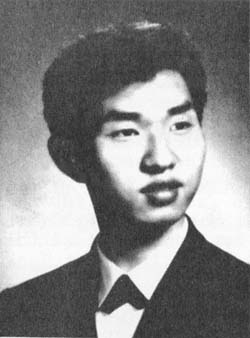The Bodhi Lectern
Introducing the Eminent Dharma Protector
UPASAKA KUO JEN WONG
--By Bhiksu Heng Kuan
Although a true teacher has an unlimited number of expedient ways to
reach his potential students, few would expect the martial arts to be an
entrance to the peaceful and harmonious life of a Buddhist adept. Even the
martial arts, however, need not be excluded from the realm of what is good, but
it takes a skilled teacher to find and bring forth the goodness.
Upasaka Kuo Jen (![]() ,Jimmy) Wong was born in Canton, China, in 1948. In 1957his
,Jimmy) Wong was born in Canton, China, in 1948. In 1957his
parents thought that a move from mainland China was in the best interest of
the family, and they journeyed to Macao where they lived for two years. In April
1960 they took up residence in the United States.
Although he knew no English, Kuo Jen began studying in English school. Within a year he was able to follow his classes and keep up with the work, but because he had "the strange ways of a foreigner" he was picked on by the other children. He decided to learn kung fu, the well known martial art of China, to protect himself; the first step in his study was to take up the practice of T'ai Chi Ch'uan. He went to the Buddhist Lecture Hail in San Francisco, Chinatown, and there was able to find someone to teach him. In the course of learning T'ai Chi he began asking questions about Buddhism, and was intrigued by tales of the heroic feats and magical transformations of the great masters of history. It was not long before he heard of the Venerable Master Hsuan Hua who at that time still resided in Hong Kong.
He was immediately impressed by the unsurpassed Way virtue of the Venerable Master. "I wrote him a letter to say hello, and ask him when he was going to come to America," Kuo Jen said, "because I thought he was a great man. I was about thirteen at the time." When the Venerable Master arrived in America, not much time passed before many people wished to become his disciples. Among those at the first transmission of the Three Refuges in America by the Master was Kuo Jen.
From the time the Master arrived Kuo Jen worked hard studying Buddhism, based on strong faith which revealed itself when he first heard the Master's name. He went to the Buddhist Lecture Hall every night to do his schoolwork and hear the Master explain the Dharma. Before long his English was good enough to translate the Master's words for the Westerners who attended the nightly sessions but were unable to understand Chinese. The Buddhist Lecture Hall seemed like a second home to him. He played the Dharma instruments in ceremonies, and served the Master in many different ways to help him begin Buddhism in the West. He also kept a record and took notes of all the Master's lectures, poems, gathas, essays and the like.
